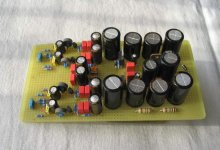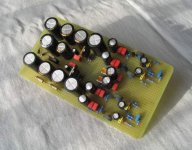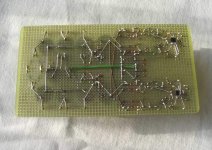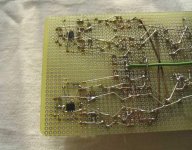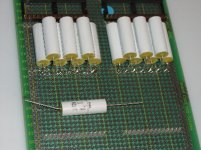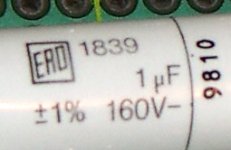Firstable big thanks to Thorsten Loesch ,who shared his circuit with us.
Recently I got the idea to buy two identical old Marantz players (CDM4/TDA1541A) to make mods on them.This gives me the chance to compare the player with mod and the one without it as I'm doing mods step by step.If I like the mod I apply it to second player and go to another one.
Building this OPA660 I-V I followed some PS suggestions of Appasanger,who biuld and posted this circuit here some time ago.The board contains PS for 5V current injection (7805 regulator) and PS for OPA 660 (317/337 as pre regulators).I didn't use coupling caps at the output as I'm using preamp with caps at the input.All parts are lower/medium quality: Vithrohm 1% metal film resistors and cheap Hitano ,low ESR 105 c. PS caps along with some Wimas.It was hard to adjust zero DC offset with the pots at first (actually imposible for the first three days),but after it burned in it's quite easy to adjust it for zero Volts.
It drifts a bit but usually no more than 5mV.
As to the sound (I've been listening to this analog stage for some two weeks ,now):
Before I was using orginal Marantz circuit with OPA-s changed for BB 2604 and getting rid of muting transistors.It surely represents higher level of performance.The soundstage is wider and there is much more details ten before.But to be honest I don'tlike it!
The sound is a little too bright and edgy for my taste.It lacks some smoothness and richness.
The bass is very well controled but there is less of it then before (tonal balance suffers a bit).Orginal moded stage has less detail and space but better tone and makes music more involving.
NON-OS mode
I tried two TDA1543 non-os DACs and didn't like it much (I don't know wheather non-os or TDA1543).I also tried this player in non-os mode with original analog stage,didn't like it either (supposedly it would have to be rebuild to work properly).
I tried this OPA660 stage in non-os ,but without adding low pass filter as suggested.
I must say this is the first time I think it sounded quite good.But still ,I prefer this one with SAA7220.Although the sound seemed more natural I hear some chaos,image seems to be a bit "cloudy" and highs a bit harsh.
The system I tried it was Aleph P and Aleph 3 clones and Altec 891 studio monitors.
Other things I'm planning to try out:
1.Rudolf's analog stage.
2.Thorsten's ECC88 tube stage.
3.Fit Pass D1 analog stage (actually unbalanced half of it).
Also some other mods like better TDA1541 PS.Separate SAA7220 PS...any ideas??
Bartek
Recently I got the idea to buy two identical old Marantz players (CDM4/TDA1541A) to make mods on them.This gives me the chance to compare the player with mod and the one without it as I'm doing mods step by step.If I like the mod I apply it to second player and go to another one.
Building this OPA660 I-V I followed some PS suggestions of Appasanger,who biuld and posted this circuit here some time ago.The board contains PS for 5V current injection (7805 regulator) and PS for OPA 660 (317/337 as pre regulators).I didn't use coupling caps at the output as I'm using preamp with caps at the input.All parts are lower/medium quality: Vithrohm 1% metal film resistors and cheap Hitano ,low ESR 105 c. PS caps along with some Wimas.It was hard to adjust zero DC offset with the pots at first (actually imposible for the first three days),but after it burned in it's quite easy to adjust it for zero Volts.
It drifts a bit but usually no more than 5mV.
As to the sound (I've been listening to this analog stage for some two weeks ,now):
Before I was using orginal Marantz circuit with OPA-s changed for BB 2604 and getting rid of muting transistors.It surely represents higher level of performance.The soundstage is wider and there is much more details ten before.But to be honest I don'tlike it!
The sound is a little too bright and edgy for my taste.It lacks some smoothness and richness.
The bass is very well controled but there is less of it then before (tonal balance suffers a bit).Orginal moded stage has less detail and space but better tone and makes music more involving.
NON-OS mode
I tried two TDA1543 non-os DACs and didn't like it much (I don't know wheather non-os or TDA1543).I also tried this player in non-os mode with original analog stage,didn't like it either (supposedly it would have to be rebuild to work properly).
I tried this OPA660 stage in non-os ,but without adding low pass filter as suggested.
I must say this is the first time I think it sounded quite good.But still ,I prefer this one with SAA7220.Although the sound seemed more natural I hear some chaos,image seems to be a bit "cloudy" and highs a bit harsh.
The system I tried it was Aleph P and Aleph 3 clones and Altec 891 studio monitors.
Other things I'm planning to try out:
1.Rudolf's analog stage.
2.Thorsten's ECC88 tube stage.
3.Fit Pass D1 analog stage (actually unbalanced half of it).
Also some other mods like better TDA1541 PS.Separate SAA7220 PS...any ideas??
Bartek
Conclusions not clear
Reading CLOSELY I believe you are saying the marants modded with opamp 2604 was more musical and involving than the more resolving but bright and edgy, less bass, less well balanced 660 circuit. But the paragraph is not very clear as to what is what..... the original marants circuit or the modded 2604 or 660 one????
Bypassing PS etc lytic caps with 0.1 UF often softens the edge, brightness and larger decoupling caps often deepen bass response.
In regards to NOS vs OS the questions are:
In a basic nonmodded player will this single change be an improvement? And also once the CDP is updated with multiple decoupled PSs, new opamps, and updated clock, then at this higher resolution will a NOS mod be an audible improvement?
You have the opportunity to do true comparisons and save a lot of time, repetition and money for others, while at the same time helpng yourself.
I would do NOS vs OS in basic unmodded or bare bone mod CDP.
I then would do basic mods to both CDPs power supplies and add an independant PS to output/IV, clock ( and new clock) and DAC then compare opamps. Reach a conclusion regarding the best opamp in this set up...results would be important as this circuit is fairly universal in the very similar TDA1541 CDPs. Then compare NOS vs OS again but in the modded more highly resolving CDP...come to a conclusion. Then go on with more refined outputs like superpair, tube outputs +/- transformer output, +/- transformer volume control output.
Free sample chips can be obtained from Analog devices. National semiconductor, Texas instruments as a student with a project
Reading CLOSELY I believe you are saying the marants modded with opamp 2604 was more musical and involving than the more resolving but bright and edgy, less bass, less well balanced 660 circuit. But the paragraph is not very clear as to what is what..... the original marants circuit or the modded 2604 or 660 one????
Bypassing PS etc lytic caps with 0.1 UF often softens the edge, brightness and larger decoupling caps often deepen bass response.
In regards to NOS vs OS the questions are:
In a basic nonmodded player will this single change be an improvement? And also once the CDP is updated with multiple decoupled PSs, new opamps, and updated clock, then at this higher resolution will a NOS mod be an audible improvement?
You have the opportunity to do true comparisons and save a lot of time, repetition and money for others, while at the same time helpng yourself.
I would do NOS vs OS in basic unmodded or bare bone mod CDP.
I then would do basic mods to both CDPs power supplies and add an independant PS to output/IV, clock ( and new clock) and DAC then compare opamps. Reach a conclusion regarding the best opamp in this set up...results would be important as this circuit is fairly universal in the very similar TDA1541 CDPs. Then compare NOS vs OS again but in the modded more highly resolving CDP...come to a conclusion. Then go on with more refined outputs like superpair, tube outputs +/- transformer output, +/- transformer volume control output.
Free sample chips can be obtained from Analog devices. National semiconductor, Texas instruments as a student with a project
zygibajt, you have poor PSU bypassing on the OPA660s, because the caps are all on the same side of the chip (far from one of the PSU pins).
This is normal even in commercial products, and if your Marantz CDP has the PSU caps positioned this way (like my CD52SE) you missed an opportunity to listen to the OPA2604 in all it's glory.

This is normal even in commercial products, and if your Marantz CDP has the PSU caps positioned this way (like my CD52SE) you missed an opportunity to listen to the OPA2604 in all it's glory.

Thanks a lot for your answers!
Goldears,
That's right!
Sorry for being unclear.I don't even consider unmoded Marantz.The basic start point for my moding was the point where the orginal Marantz had installed Kwak Clock 7 , op-amps changed for 2604 , exchanged all electrolitics for Panasonic FC , and without muting transistors at the output.
I changed to non-os mode original unmoded player and also the player that I consider a start point.In both cases non-os sounded much worst then oversampling! I think somebody (might be Guido) had said that output circuit have to be redesigned for non os mode.This might be true.
Now,this OPA660 I-V circuit ,as I've heard doesn't care non-os or os.There might be low pass filter added but it's not MUST do.I didn't put this low pass filter but tried non-os.As I said it sounded quite good and some areas of the sound were better but I'm not sure if I like it better then os.I guess I might try ones again.
That is what I've done ,mostly.The best op-amp was 2604 in my Marantz.I also moded Rotel 855 (similar build and same chips) and it sounded better with 2134 (more smooth than 2604).
Now I ordered S1 chips and also will try to build separate PS for TDA1541 and maybe SAA7220.As to op-amps you can't substitute OPA660 with other chip becouse this is not regular op-amp.
Carlosfm
What exactly do you mean by that?
From the point where the big caps on the picture end, every OPA660 has its own + and - supply with own caps.
I don't use 2604 and orginal Marantz analog output circuit now.The output from the DAC is taken to the board from the picture,so don't exactly understand what you mean.
Now, I still listen to and use this OPA 660 analog stage and I must say it sound really good,no comparison to moded Marantz's output circuitry,but still not my taste.
Will soon try tube or super pair.
All best.
Bartek
Goldears,
Reading CLOSELY I believe you are saying the marants modded with opamp 2604 was more musical and involving than the more resolving but bright and edgy, less bass, less well balanced 660 circuit
That's right!
But the paragraph is not very clear as to what is what..... the original marants circuit or the modded 2604 or 660 one????
Sorry for being unclear.I don't even consider unmoded Marantz.The basic start point for my moding was the point where the orginal Marantz had installed Kwak Clock 7 , op-amps changed for 2604 , exchanged all electrolitics for Panasonic FC , and without muting transistors at the output.
In regards to NOS vs OS the questions are:
I changed to non-os mode original unmoded player and also the player that I consider a start point.In both cases non-os sounded much worst then oversampling! I think somebody (might be Guido) had said that output circuit have to be redesigned for non os mode.This might be true.
Now,this OPA660 I-V circuit ,as I've heard doesn't care non-os or os.There might be low pass filter added but it's not MUST do.I didn't put this low pass filter but tried non-os.As I said it sounded quite good and some areas of the sound were better but I'm not sure if I like it better then os.I guess I might try ones again.
I then would do basic mods to both CDPs power supplies and add an independant PS to output/IV, clock ( and new clock) and DAC then compare opamps. Reach a conclusion regarding the best opamp in this set up...results would be important as this circuit is fairly universal in the very similar TDA1541 CDPs. Then compare NOS vs OS again but in the modded more highly resolving CDP...come to a conclusion
That is what I've done ,mostly.The best op-amp was 2604 in my Marantz.I also moded Rotel 855 (similar build and same chips) and it sounded better with 2134 (more smooth than 2604).
Now I ordered S1 chips and also will try to build separate PS for TDA1541 and maybe SAA7220.As to op-amps you can't substitute OPA660 with other chip becouse this is not regular op-amp.
Carlosfm
zygibajt, you have poor PSU bypassing on the OPA660s, because the caps are all on the same side of the chip (far from one of the PSU pins).
What exactly do you mean by that?
From the point where the big caps on the picture end, every OPA660 has its own + and - supply with own caps.
you missed an opportunity to listen to the OPA2604 in all it's glory.
I don't use 2604 and orginal Marantz analog output circuit now.The output from the DAC is taken to the board from the picture,so don't exactly understand what you mean.
Now, I still listen to and use this OPA 660 analog stage and I must say it sound really good,no comparison to moded Marantz's output circuitry,but still not my taste.
Will soon try tube or super pair.
All best.
Bartek
Hi,
I just want to report that I just changed yesterday all 14 decoupling caps on TDA1541A!
I must say the diffrance is quite big and wothwhile!
Especially in case of those SMD ones.I just threw all of them away and put 14 1uF/63V Philips film caps at the top side of the PCB,directly on the pins (sorry ,no picture right now).
Great mod! More detail,bass and lower midrange got much better.
If anyone have any suggestions for better type of those caps than Philips I would appreciate it (I already used SEARCH function on that but maybe some fresh expirences?).
The only thing is they have to be small in size.
Please write "OPA660 I-V" in search mode and You will get it!
All Best
Bartek
I just want to report that I just changed yesterday all 14 decoupling caps on TDA1541A!
I must say the diffrance is quite big and wothwhile!
Especially in case of those SMD ones.I just threw all of them away and put 14 1uF/63V Philips film caps at the top side of the PCB,directly on the pins (sorry ,no picture right now).
Great mod! More detail,bass and lower midrange got much better.
If anyone have any suggestions for better type of those caps than Philips I would appreciate it (I already used SEARCH function on that but maybe some fresh expirences?).
The only thing is they have to be small in size.
where can I look at the schematic?
Please write "OPA660 I-V" in search mode and You will get it!
All Best
Bartek
You could use these:
ERO MKP 1839 1µF
I don't want to be threadjacking , but
, but
is it ok to connect all grounds to a groundplane ? , see pic...
Or will I have problems ?
The black sockets will be removed, they just hold single pin sockets until after soldering, so the TDA will be as close to the board as without socket.
ERO MKP 1839 1µF
I don't want to be threadjacking
 , but
, but is it ok to connect all grounds to a groundplane ? , see pic...
Or will I have problems ?
The black sockets will be removed, they just hold single pin sockets until after soldering, so the TDA will be as close to the board as without socket.
Attachments
zygibajt said:Firstable big thanks to Thorsten Loesch ,who shared his circuit with us.
Recently I got the idea to buy two identical old Marantz players (CDM4/TDA1541A) to make mods on them.This gives me the chance to compare the player with mod and the one without it as I'm doing mods step by step.If I like the mod I apply it to second player and go to another one.
Building this OPA660 I-V I followed some PS suggestions of Appasanger,who biuld and posted this circuit here some time ago.The board contains PS for 5V current injection (7805 regulator) and PS for OPA 660 (317/337 as pre regulators).I didn't use coupling caps at the output as I'm using preamp with caps at the input.All parts are lower/medium quality: Vithrohm 1% metal film resistors and cheap Hitano ,low ESR 105 c. PS caps along with some Wimas.It was hard to adjust zero DC offset with the pots at first (actually imposible for the first three days),but after it burned in it's quite easy to adjust it for zero Volts.
It drifts a bit but usually no more than 5mV.
As to the sound (I've been listening to this analog stage for some two weeks ,now):
Before I was using orginal Marantz circuit with OPA-s changed for BB 2604 and getting rid of muting transistors.It surely represents higher level of performance.The soundstage is wider and there is much more details ten before.But to be honest I don'tlike it!
The sound is a little too bright and edgy for my taste.It lacks some smoothness and richness.
The bass is very well controled but there is less of it then before (tonal balance suffers a bit).Orginal moded stage has less detail and space but better tone and makes music more involving.
NON-OS mode
I tried two TDA1543 non-os DACs and didn't like it much (I don't know wheather non-os or TDA1543).I also tried this player in non-os mode with original analog stage,didn't like it either (supposedly it would have to be rebuild to work properly).
I tried this OPA660 stage in non-os ,but without adding low pass filter as suggested.
I must say this is the first time I think it sounded quite good.But still ,I prefer this one with SAA7220.Although the sound seemed more natural I hear some chaos,image seems to be a bit "cloudy" and highs a bit harsh.
The system I tried it was Aleph P and Aleph 3 clones and Altec 891 studio monitors.
Other things I'm planning to try out:
1.Rudolf's analog stage.
2.Thorsten's ECC88 tube stage.
3.Fit Pass D1 analog stage (actually unbalanced half of it).
Also some other mods like better TDA1541 PS.Separate SAA7220 PS...any ideas??
Bartek
Bartek,
The OPA660 is a good idea from the outset but when you
really think it through it has too many limitations for really
ultimate 0 FB I-V conversion.
- It only runs from +-6V max, BJT's always sound better with
more PS headroom. This is usually due to C-B (miller) capacitance
modulation and is quite measurable. It is a big issue in a 0 FB
circuit because there is no FB to correct it.
- The 660 is limited WRT how much quiescent current you can run.
The 26mA max current seems like a lot but once you divide it
up to all the internal BJT's, there is actually not a whole lot of
current.
- You are limited with choice of BJT's that are used and what
parameters they have . For my latest I-V, I hand selected BJT's
that have a HFE modulation (over the +-2mA operating range) of
0.02% (my measurement limit).
Check out the super pair I-V by Rudolf, much better solution and
much more flexible.
http://www.diyaudio.com/forums/showthread.php?s=&threadid=25051&perpage=15&highlight=&pagenumber=1
WRT your implementation, you really need to use a ground plane.
If hand wiring, grab a peice of copper sided PCB and go from
there.
Cheers,
Terry
For 5 pairs of transistors inside the OPA660, 26mA of current is quite a lot. So, almost certainly, this is not a major issue here.Terry Demol said:The 660 is limited WRT how much quiescent current you can run.
The 26mA max current seems like a lot but once you divide it
up to all the internal BJT's, there is actually not a whole lot of
current.
Pedja
Pedja said:
For 5 pairs of transistors inside the OPA660, 26mA of current is quite a lot. So, almost certainly, this is not a major issue here.
Pedja
Well, as I said, from the outset all seems OK but you must
look carefully at data sheet at ALL the information and then
consider the application.
From the simplified schematic, the quiescent current is shared
between 8 matched transistor arrays. Refer to OTA
transconductance and this will tell the rest of the story.
At max bias current, transconductance = 106mA / V.
Taking into account complimentary topology and other factors
(rBE) and I would say that the bias current would not be much
more than 3mA (if that) for the pair that DAC feeds (emitter).
For a dac that OP's +-2mA and has finite OP Z of around 1 to 2k
this will mean poor linearity.
Cheers,
Terry
- Status
- This old topic is closed. If you want to reopen this topic, contact a moderator using the "Report Post" button.
- Home
- Source & Line
- Digital Source
- My OPA 660 I-V stage for TDA 1541A
